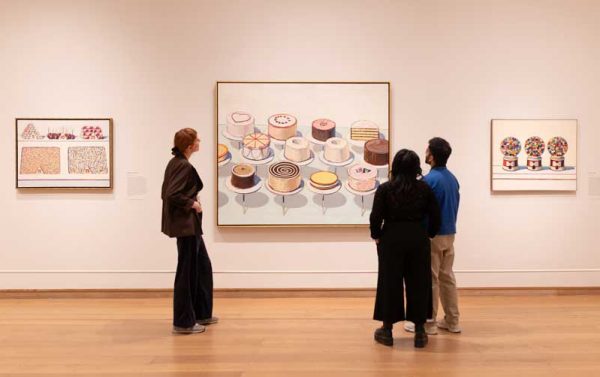First UK Museum Exhibition of Wayne Thiebaud opens at The Courtauld Gallery

The Courtauld Gallery unveiled the first-ever museum exhibition in the UK on the celebrated modern American artist Wayne Thiebaud (1920–2021). The Griffin Catalyst Exhibition: Wayne Thiebaud. American Still Life is on display from 10 October 2025 – 18 January 2026.
One of the most original American artists of the 20th century, Thiebaud developed a unique style of painting to express his vision of post-war American culture through its everyday objects.
The exhibition at The Courtauld Gallery focuses on Thiebaud’s break-out works of the 1960s that made his reputation and brings together some of the greatest paintings the artist produced during this remarkable period – lush and captivating depictions of quintessential modern American subjects, from cherry pies, hot dogs and candy counters to gumball dispensers and pinball machines. With these works, Thiebaud recast the genre of still life for the modern era.
In 1962, Thiebaud asserted, ‘Each era produces its own still life.’ Steeped in art history, he considered his work as continuing the radical legacy of artists such as Jean-Siméon Chardin, Paul Cézanne and Édouard Manet. Thiebaud saw the commonplace objects of his own time – iconic features of American consumer culture – as vital subjects for contemporary art. His works transformed everyday delights such as lemon meringue pies and glossy cream cakes into the stuff of serious modern painting. Thiebaud’s vibrantly coloured pictures of the offerings of American diners, bakeries and stores are painterly meditations on their subjects, which draw the viewer deep into the world they represent.
Painted during a period of American economic boom and optimism but also increasingly of dissent and change, Thiebaud’s still lifes belie their direct and simple appearance. Within a single work, a sense of abundance and desire can give way to feelings of isolation and longing.
Thiebaud lived and worked most of his life in Sacramento, California, and was a longstanding teacher at nearby University of California, Davis. In the 1940s and 1950s, before becoming a painter, he worked as an illustrator, cartoonist and art director, including a summer spent in the animation department of Walt Disney Studios and a role as a graphic designer for the US army as part of his military service during the Second World War.
In 1956, Thiebaud travelled to New York to meet the avant-garde artists working there. Willem de Kooning was especially inspirational and encouraged him to find his own voice and subjects as a modern painter. Back in Sacramento, he began painting commonplace objects of American life, largely from memory, and soon crystallised his unique approach, isolating his richly painted subjects against spare backgrounds. In 1961, he took this group of modern still lifes to New York looking for a gallery to show them. Having faced rejection from most, he made a last stop at a gallery run by a young dealer, Allan Stone, who took him on. The following year, Thiebaud staged his first solo show at the Allan Stone Gallery, which was an overnight success, propelling him into the limelight. Important collectors and institutions, including the Museum of Modern Art, purchased works and the exhibition sold out. From there, Thiebaud would go on to become one of the major figures of 20th-century American art.
In that same year, 1962, Thiebaud was featured, alongside artists such as Andy Warhol and Roy Lichtenstein, in two historic shows that established the Pop Art movement. Although his work coincided with Pop Art, Thiebaud never considered himself part of the movement. Rather than being rooted in advertising graphics, methods of mass reproduction, and concerned with flat, print-like surfaces, Thiebaud’s work is painterly almost to the point of exaggeration. He exploited the physical properties of paint to create an intense and captivating expression of his chosen subjects.
The exhibition features rarely lent works from major museums and private collections in the United States. Highlights include Thiebaud’s epic painting Cakes, lent for the first time outside the US by the National Gallery of Art, Washington, D.C., and Four Pinball Machines, one of his most significant works in a private collection. Other major loans include works from the Whitney Museum of Art, New York; the Smithsonian American Art Museum, Washington, D.C.; and the Fine Art Museums of San Francisco, among others. The exhibition also benefits from generous loans from the Wayne Thiebaud Foundation in Sacramento.
An accompanying display in the Gilbert and Ildiko Butler Drawings Gallery, Wayne Thiebaud. Delights, focuses on the artist’s celebrated 1965 portfolio of 17 exquisite etchings to offer further insight into his still-life motifs and work as a graphic artist.
In addition to holding one of the few works by Thiebaud in a UK public collection – the pen-and-ink drawing Cake Slices from 1963 – The Courtauld offers a rich context for the exploration of Thiebaud’s remaking of the genre of still life. Most notably, it will be fascinating to consider his work in relation to Manet’s A Bar at the Folies-Bergère, a painting Thiebaud greatly admired. With its counter line-up of tempting treats, from mandarins to champagne, it is the defining precursor painting of modern consumer culture and society.
Main Image: Copyright Fergus Carmichael/The Courtauld
